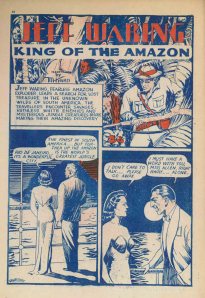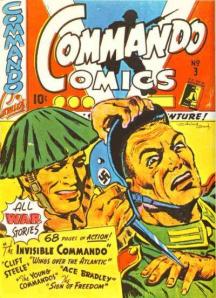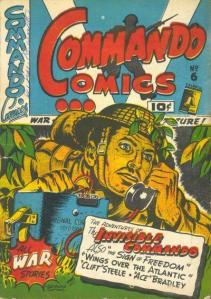 Murray Karn began his career with Bell Features in early 1942 while the publisher was still under the name Commercial Signs of Canada. Only 18 at the time, much of his original work was done for the Thunderfist and Jeff Waring storylines.
Murray Karn began his career with Bell Features in early 1942 while the publisher was still under the name Commercial Signs of Canada. Only 18 at the time, much of his original work was done for the Thunderfist and Jeff Waring storylines.
Karn worked on ‘Thunderfist’ in Active comics and was the most consistent artist for the line. His talents were not overlooked at Bell Features; he also did several covers for Active Comics as well as working on the ‘Jeff Waring of the Amazon’ storyline of his own creation. It was released about a month after ‘Thunderfist’ in March of 1942 and was run in Wow Comics, Bell Features’ first comic title.
Karn continued to work regularly for Bell Features for the next two years as artist on these and other lines including Captain Red Thorton, Rex Baxter and Scotty MacDonald. He even contributed artwork to the narrative shorts in Triumph Comics, all under Bell Features. Within a couple years, Karn went into the Medical Corps but continued cartooning for the wounded troops to raise their spirits.
 As Bell Features continued to gain prominence in Canada’s comic book industry, Karn was easily accepted back into the ranks just shortly before the end of Canada’s Golden Age and finished the last two issues on Jeff Waring. Shortly after, Karn went to New York to pursue other opportunities.
As Bell Features continued to gain prominence in Canada’s comic book industry, Karn was easily accepted back into the ranks just shortly before the end of Canada’s Golden Age and finished the last two issues on Jeff Waring. Shortly after, Karn went to New York to pursue other opportunities.
His classic and realistic style make his comics very easy to spot and a pleasure to view. His characters, nothing short of perfection, are elegantly composed, both on the paper and in character. Karn’s style at this time was almost reminiscent of a twenties chic with his big eyed beauties and his men modeled much like Clark Gable. Specifically, Karn’s style was distinctive in such a way that his comics were of a much higher caliber.
Murray Karn currently resides in New York and is a part of the Southampton Artists Society. Find out more on his work in the upcoming documentary Lost Heroes.

 Bell Features, the truest of Canadian Golden Age comics published several titles during the 40’s including the aforementioned Active Comics.
Bell Features, the truest of Canadian Golden Age comics published several titles during the 40’s including the aforementioned Active Comics. Like Active Comics, Commando Comics was themed, and in this case, based heavily on combat, war, secret missions, the Axis, and really, all other things commando. This theme was common during the war as it fueled nationalism and support and provided a more realistic hero. Active comics’ had Dixon of the Mounted, The Brain, Thunderfist, Active Jim and Captain Red Thorton which all featured daring action adventure stories. Likewise, Commando Comics had The Young Commandos, The Sign of Freedom, Wings Over the Atlantic, The Invisible Commando, Ace Bradley and Clift Steele. These stories shared a similar theme and formula which is evident in the cover pages pictured, and produced a very tight comic. This consistency lasted until about issue #15 when some of the more regular titles began to slowly drop off.
Like Active Comics, Commando Comics was themed, and in this case, based heavily on combat, war, secret missions, the Axis, and really, all other things commando. This theme was common during the war as it fueled nationalism and support and provided a more realistic hero. Active comics’ had Dixon of the Mounted, The Brain, Thunderfist, Active Jim and Captain Red Thorton which all featured daring action adventure stories. Likewise, Commando Comics had The Young Commandos, The Sign of Freedom, Wings Over the Atlantic, The Invisible Commando, Ace Bradley and Clift Steele. These stories shared a similar theme and formula which is evident in the cover pages pictured, and produced a very tight comic. This consistency lasted until about issue #15 when some of the more regular titles began to slowly drop off. It wasn’t really a surprise when Bell Features again began changing their lineup. Slowly, almost all of the above titles were phased out and replaced with gag comics or funnies by Robert Young, Thomas, Frank Keith, Harry Brunt and Hy Moyer. For stories they started using titles like the Polka Dot Pirate (A female avenger of sorts), Ruff and Reddy, Mr. Distracted Attorney, Salty Lane (Secret Investigator), Dick Stone, Chick Tucker and Flame Berns. There was even a Doc Stearne thrown in there. Beyond the obvious ridiculousness of the characters, the comic became unrecognizable to its former self.
It wasn’t really a surprise when Bell Features again began changing their lineup. Slowly, almost all of the above titles were phased out and replaced with gag comics or funnies by Robert Young, Thomas, Frank Keith, Harry Brunt and Hy Moyer. For stories they started using titles like the Polka Dot Pirate (A female avenger of sorts), Ruff and Reddy, Mr. Distracted Attorney, Salty Lane (Secret Investigator), Dick Stone, Chick Tucker and Flame Berns. There was even a Doc Stearne thrown in there. Beyond the obvious ridiculousness of the characters, the comic became unrecognizable to its former self.